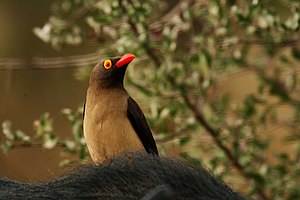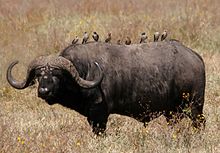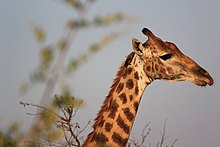Maggot chopper
| Maggot chopper | ||||||||||||
|---|---|---|---|---|---|---|---|---|---|---|---|---|

A red-billed maggot chopper ( Buphagus erythrorhynchus ) on a buffalo |
||||||||||||
| Systematics | ||||||||||||
|
||||||||||||
| Scientific name of the family | ||||||||||||
| Buphagidae | ||||||||||||
| Lesson , 1828 | ||||||||||||
| Scientific name of the genus | ||||||||||||
| Buphagus | ||||||||||||
| Brisson , 1760 |
The Madenhackerstare , also called Madenhacker or Buphagus for short , are the only genus of the bird family Buphagidae . The group includes only two species, which are classified based on their beak color and whose natural habitat is the savannas of central and eastern Africa south of the Sahara . Both species live there in open symbiosis with large domestic or wild animals .
Previously, the maggot chopper were usually placed as a subfamily Buphaginae to the starlings (Sturnidae).
Way of life
Maggot chopper are sociable birds that feed on insects and their larvae as well as ticks . To do this, they often stay on large wild animals or herds of domestic animals and let them carry them around. Among other things, they search the fur of the animals for parasites and remove them with their powerful beaks . They also warn their host animals of approaching predators, giving them, for example, on Swahili name "askari wa Kifaru" (Rhino 'in German about, Guardian) earned. According to new observations, however, the population of maggot hackers is falling.
Maggot hackers have strong feet and are good fliers. Their plumage is light brown. The two species differ in their beak color. The birds nest in holes, often in walls lined with hair from their host animals. There they hatch two or three eggs.
Cleaning symbiosis

Even if maggot hackers do not necessarily have to rely on a host , they prefer to live with it, as it offers them protection and food. Their physique is also adapted to this. So far, the relationship has been understood as a typical cleaning symbiosis that not only contributes to the health of the host, but also reduces the risk of epidemics for the herd.
However, this view has recently been called into question. The English zoologist Paul Weeks came to the conclusion that the relationship between the maggot hackers and their hosts is parasitic. By examining the feeding behavior of red-billed maggot cattle on a group of domestic cattle in Zimbabwe , Weeks found that they spend only 15 percent of their time killing parasites. The rest of the time they spend pecking in the animals' wounds, keeping them open, eating their earwax or looking for food in the fur in some other way . In this case, the blood and small bits from the wound edges were preferred as food.
A further investigation showed that cattle from which the maggot chopper were driven away were no more infested with parasites than a “cleaned” comparison group. It remains to be clarified whether these results can be transferred to the approximately 25 other large game species in Zimbabwe.
Systematics and tribal history
The maggot hackers were mostly assigned to the starling family as the subfamily Buphaginae . Based on the results of genetic comparative studies, however, they are now regarded as a separate family (Buphagidae), as they are more distantly related to the other starlings and represent basic representatives that have survived in their ecological niche. The genus is said to have originated in Southeast Asia.
The two recognized species are the red-billed maggot chopper ( Buphagus erythrorhynchus ) and the yellow-billed maggot chopper ( Buphagus africanus ) from sub-Saharan Africa.
See also
Web links
Individual evidence
- ↑ a b Small birds protect rhinos from poachers. In: Spektrum.de . April 9, 2020, accessed July 27, 2020 .
- ↑ Paul Weeks: Interactions between red-billed oxpeckers, Buphagus erythrorhynchus, and domestic cattle, Bos taurus, in Zimbabwe. In: Animal Behavior. Volume 8, No. 6, 1999, pp. 1253-1259, doi : 10.1006 / anbe.1999.1265 , PMID 10600147
- ↑ Dario Zuccon et al .: Nuclear and mitochondrial sequence data reveal the major lineages of starlings, mynas and related taxa. In: Molecular Phylogenetics and Evolution. Volume 41, No. 2, November 2006, pp. 333-344. doi : 10.1016 / j.ympev.2006.05.007
